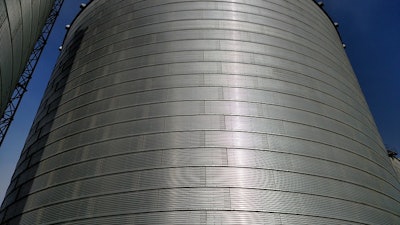
The world of grain trading is volatile at any time, but never more so than over the past five years. In that time, the industry has seen commodity prices bottom out, unpredictable weather, and trade disputes. This year alone the grain industry has seen flooding destroy stored product across the Midwest and slow shipping along rivers, escalating trade tensions between the United States and China, and a late planting season in the Midwest.
With all these variables, one of the most potent weapons grain handlers have in their arsenal is the ability to store grain until the conditions are right to sell it. That means potentially storing the product for longer than expected or in fluctuating conditions. Feed & Grain sat down with Samuel Cook, lecturer for the Department of Agricultural and Biosystems Engineering at Iowa State University, to talk about using aeration to manage long-term grain quality.
Feed & Grain:What are some of the best practices for storing grain long term?
Samuel Cook:For long-term storage, make sure the grain is put in with the recommended moisture content. Once the grain is at the safe moisture content level, it becomes about getting the grain down to the right temperature through aeration and then monitoring the grain.
When monitoring, if the grain starts to get a hot spot or the overall temperature is increasing then something in the grain is causing it. Whether it be mold, fungus or an insect infestation, it’s important to diagnose and treat the problem quickly.
Grain is a really good insulator, so it should not be too hard to keep already cold grain cold during the spring and early summer. At that point you just keep monitoring the grain.
F&G:How should aeration practices change with the seasons?
Cook:My experience is with corn and soybeans in Iowa. Typically in our section of the Midwest, we do a step-wise aeration. Once the grain is harvested and ready to be stored, around October, the external temperature gets down to 50-60 F and that is when the grain handler should start running the aeration fans. Run a cooling cycle through the grain and get the temperature down around 50 F. Then wait until the temperatures get a little lower, run another cooling cycle again to bring the grain down to the 40 F range. We do a step process rather than trying to blast the grain once the temperature hits 40 F. This is important because you may not have time to wait for temperature to reach 40 F — especially for people who want to store grain for long periods and cannot risk the grain developing problems.
Once winter arrives, some people want to continue aeration and freeze their grain — we are not recommending anyone freeze grain. That could lead to problems in the spring, with repeated freezing and thawing along with condensation. As long as the grain is at that 40 F mark, the only thing we recommend is making sure the fans are sealed. We have seen everything from a metal plate to a garbage bag with a bungee strap over the fan. There just needs to be something covering where the air goes into the fan. This will prevent the cold air from getting sucked out when the temperatures get warmer.
在春季和夏季,当日子开始getting warmer, we recommend monitoring the head space of the top of the bin for condensation build up. The air inside of that part of the bin gets warmed during the day then cools off at night, and condensation can happen. Monitor that area and if the bin has ventilation fans in the roof, use them to clear out the moisture.
F&G:What equipment should be used to aid in long-term storage?
Cook:A handheld CO2 monitor is very affordable and will be helpful when monitoring grain. They are simple to use. As a facility runs its aeration fans, a worker will go to the fan and measure the peak levels of CO2. They document that number and over time the facility will have an idea what the average CO2 for that bin should be. If there is an increase or spike in the CO2, it’s a sign that there is some type of biological activity going on in the bin — anything from mold, insects or spoilage.
The advantage of a CO2 monitor is, because grain is such a good insulator, a temperature cable must be almost right on top of the problem to be able to detect the increase in temperature that biological activity is causing. It’s going to take quite some time for the heat to generate outward and be picked up by the cable. Because CO2 is a gas that can permeate right through the grain and move quickly, any indicator of biological activity and spoilage will be picked up fast and the problem can be dealt with before it spreads to other parts of the bin.
There are also moisture cables that can be installed in a bin. While they’re called moisture cables, they actually measure the temperature and humidity, then calculate the Equilibrium Moisture Content. These can measure the temperature of grain in the bin as well as the outside weather conditions. It will calculate all those variables and help determine what aeration actions should be taken to keep the grain where the facility wants it.
F&G:What is the most important factor to be able to store grain long term?
Cook:Monitor the grain — especially if you are storing long term. Assuming it is initially stored at a safe moisture content, then it becomes truly important to keep the grain at the right temperature. Ideally the owner will monitor the grain every week in the spring, summer and fall. Then they will be fine with checking it every two weeks in the winter. ■

.jpg?auto=format%2Ccompress&crop=faces&fit=crop&h=48&q=70&w=48)




















